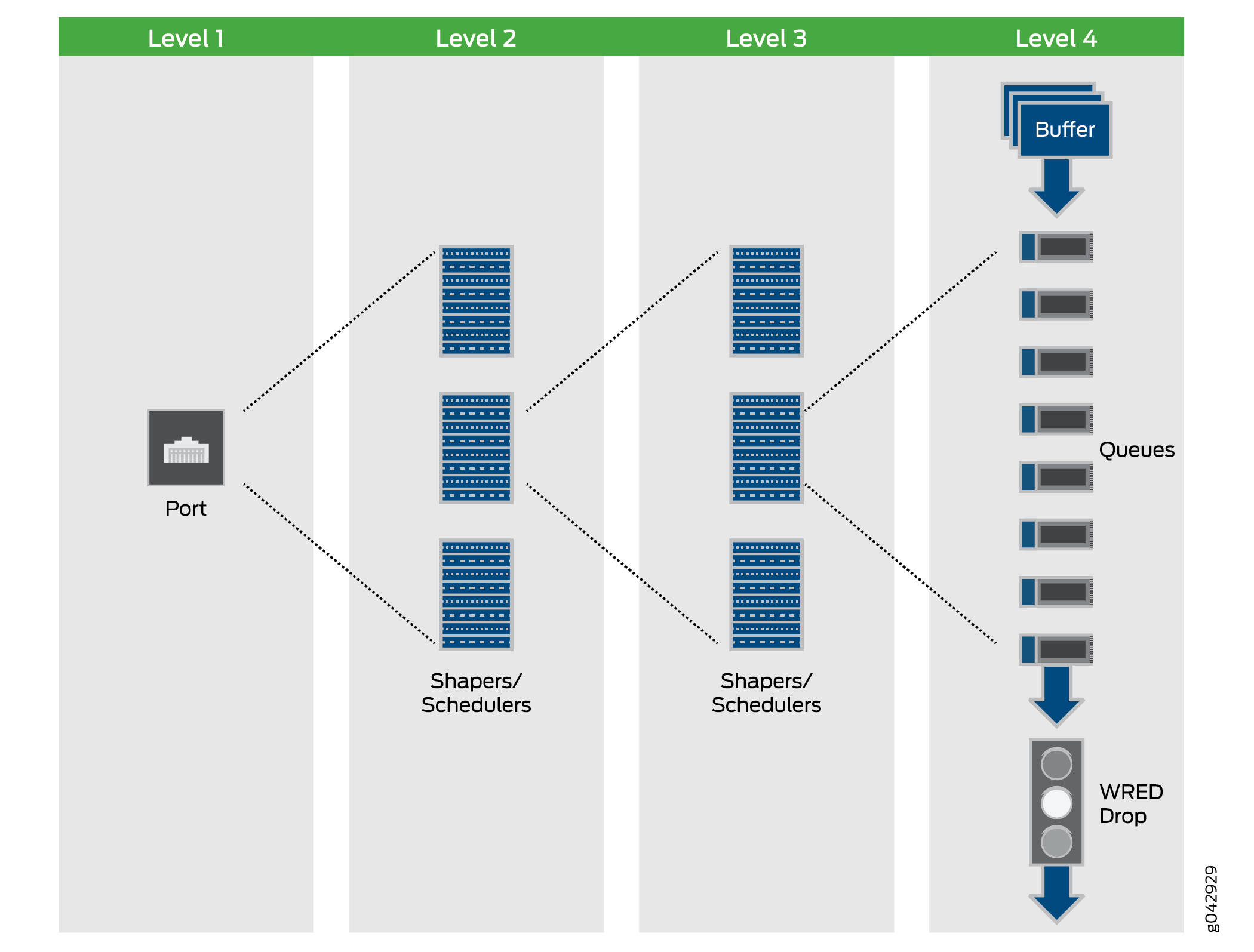Hierarchical Class of Service Overview
Hierarchical class of service (HCoS) is the ability to apply traffic schedulers and shapers to a hierarchy of scheduler nodes. Each level of the scheduler hierarchy can be used to shape traffic based on different criteria such as application, user, VLAN, slice, and physical port.
This allows you to support the requirements of different services, applications, and users on the same physical device and physical infrastructure.
HCoS is implemented primarily using traffic classifiers at the ingress and hierarchical schedulers and shapers at the egress.
A classifier is a filter that labels traffic at the device ingress based on configurable parameters such as application or destination. Traffic is classified into what is called a forwarding equivalence class (FEC). The FEC defines a class of traffic that receives common treatment.
Schedulers, and their associated shapers, are the functions that control the traffic bandwidth, jitter (delay variation), and packet loss priority at the egress of the device.
Hierarchical schedulers are used to apply multiple levels of scheduling and shaping with each level applied to different classifications such as forwarding equivalence class, VLAN, and physical interface (port) as shown in Figure 1.

Hierarchical class of service is also referred to as Hierarchical Quality of Service (HQoS) in other vendor’s documentation.
A typical application of HCoS is to configure multiple levels of egress schedulers and shapers, at the subscriber edge, using dynamic profiles to provide traffic shaping and prioritization at the subscriber VLAN level and for multiple classes of traffic.
Dynamic profiles are a mechanism that allows you to dynamically apply schedulers and shapers to individual subscribers or groups of subscribers.
To learn more about HCoS, the following topics are very helpful:
-
Junos CoS on MX Series 5G Universal Routing Platforms Overview
-
CoS Features of the Router Hardware, PIC, MIC, and MPC Interface Families
-
Hierarchical Class of Service for Subscriber Management Overview
The Junos OS hierarchical schedulers support up to five levels of scheduler hierarchies on MX Series devices when using enhanced queuing Dense Port Concentrators (DPCs) or fine-grained queuing Modular Port Concentrators (MPCs), and Modular Interface Cards (MICs). It is important to know the capabilities of your hardware with respect to HCoS. The following are a few tips to help you:
-
Only certain hardware supports the five-level scheduler hierarchy of HCoS.
-
The number of queues and logical interfaces supported is dependent upon exactly what hardware you are using.
-
The MX Series Packet Forwarding Engine handles guaranteed bandwidth and scheduler node weight differently than other Packet Forwarding Engines.
-
The fine-grained queuing MPCs and MICs have a certain granularity with respect to the shaping and delay buffer values. The values used are not necessarily exactly the values configured.
To learn more about platform support for HCoS, use the Juniper Networks Feature Explorer (https://pathfinder.juniper.net/feature-explorer/). In the Feature Explorer, search on hierarchical schedulers.
In addition, it is important to note the following:
-
HCoS is most frequently used to enforce service level agreements at the subscriber edged using dynamic traffic control profiles.
-
Hierarchical schedulers can also be applied to Ethernet pseudowire interfaces, aggregated Ethernet interfaces, Layer 2 Tunnel Protocol (L2TP) network server (LNS) inline services, and GRE tunnels.
-
Hierarchical ingress policing is a feature that is complimentary to and often used in conjunction with HCoS.
-
There are other features in Junos OS that have similar sounding names.
The hierarchical scheduler and shaper feature supported on the SRX Series Firewalls is not the HCoS feature described here.
Before planning HCoS for you network, you should learn about HCoS, define you needs, plan how you want to implement HCoS, and test the operation in a simulated environment.
|
Document |
Description |
|---|---|
|
Day One: Deploying Basic QoS Juniper Networks Books |
This book is a good resource for learning the basics of CoS on Juniper Networks devices. |
|
Juniper MX-Series O'Reilly Media |
Learn about the advanced features of HCoS. This book provides an in-depth description of how HCoS works and how it can be deployed. It also provides a lab tested topology and configuration example. |
|
Day One: Dynamic Subscriber Management Juniper Networks Books |
Learn how to use HCoS in conjunction with dynamic traffic control profiles for subscriber management. This book also includes troubleshooting. |
|
QoS Enabled Networks John Wiley & Sons |
This book is an additional source for studying QoS. |
Documentation related to HCoS is consolidated in the Hierarchical Class of Service User Guide.
Platform-Specific HCoS Behavior
Use the following table to review platform-specific behaviors for your platform.
|
Platform |
Difference |
|---|---|
|
PTX10008 |
By default, PTX10008 routers boot with PTX10K-LC1301-36DD line cards in interop
mode. This mode does not support hierarchical class of service (HCoS)
configuration on the PTX10K-LC1301-36DD line card. To enable HCoS on this line
card, run the |
